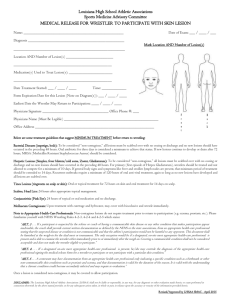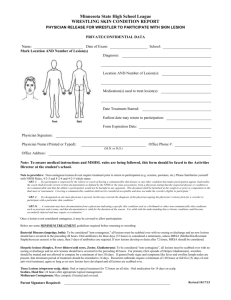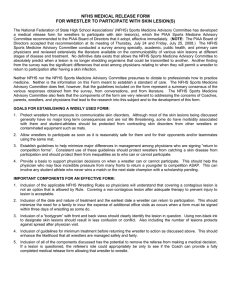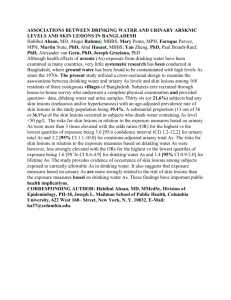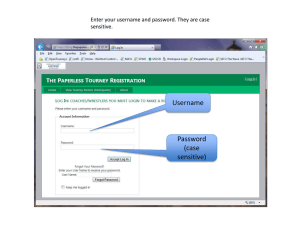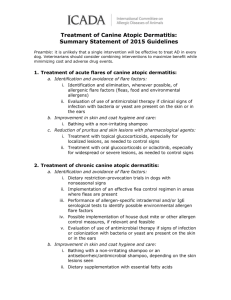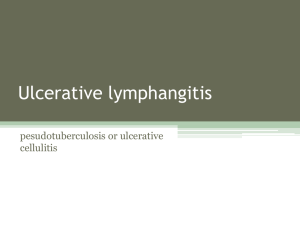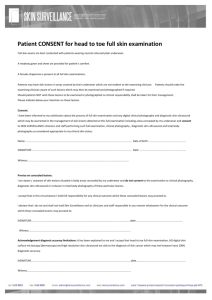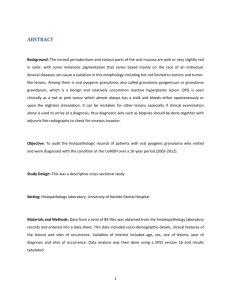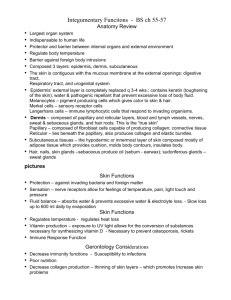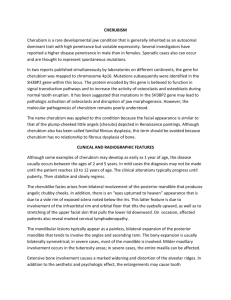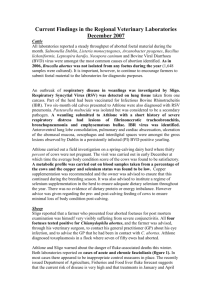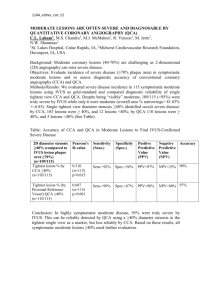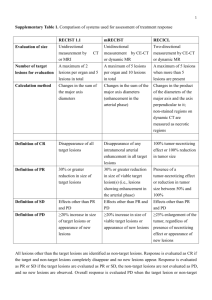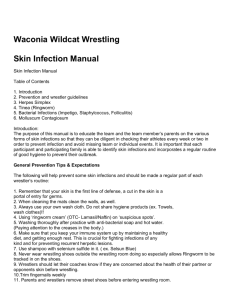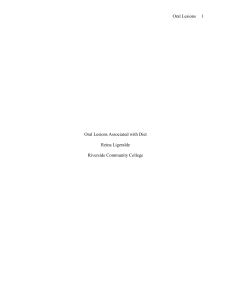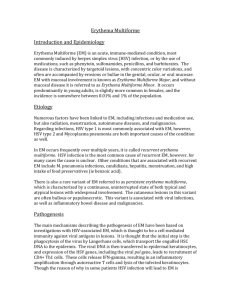WR111 Skin Condition Form - Kentucky High School Athletic
advertisement
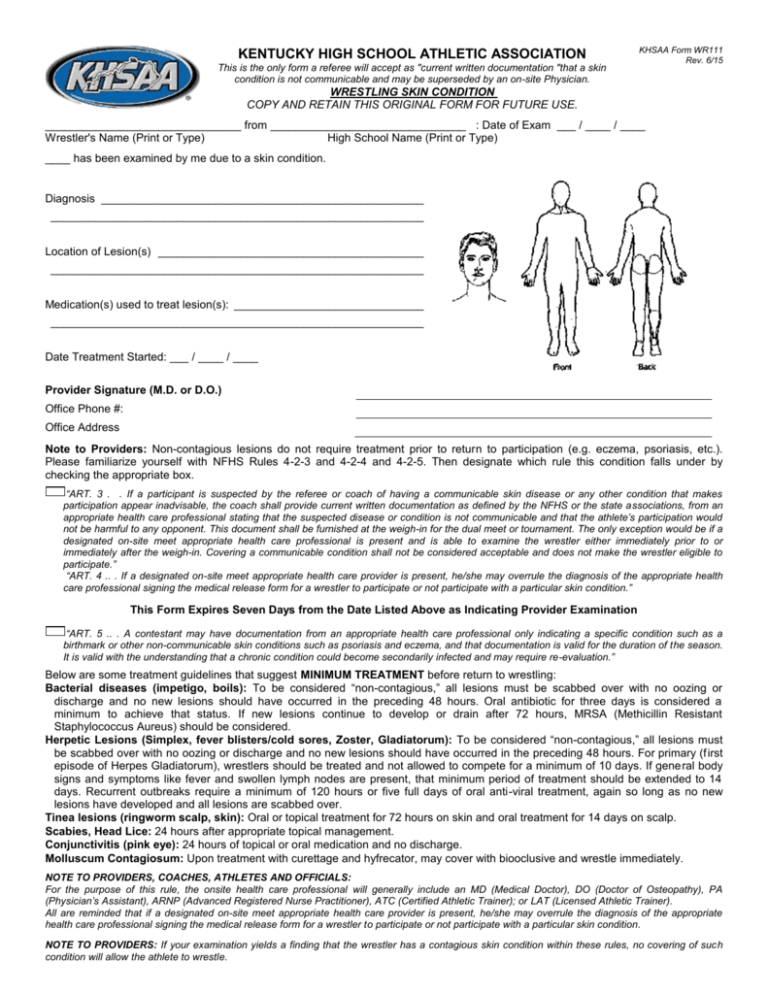
KENTUCKY HIGH SCHOOL ATHLETIC ASSOCIATION This is the only form a referee will accept as "current written documentation "that a skin condition is not communicable and may be superseded by an on-site Physician. KHSAA Form WR111 Rev. 6/15 WRESTLING SKIN CONDITION COPY AND RETAIN THIS ORIGINAL FORM FOR FUTURE USE. _______________________________ from _______________________________ : Date of Exam ___ / ____ / ____ Wrestler's Name (Print or Type) High School Name (Print or Type) ____ has been examined by me due to a skin condition. Diagnosis ___________________________________________________ ___________________________________________________________ Location of Lesion(s) __________________________________________ ___________________________________________________________ Medication(s) used to treat lesion(s): ______________________________ ___________________________________________________________ Date Treatment Started: ___ / ____ / ____ Provider Signature (M.D. or D.O.) Office Phone #: Office Address Note to Providers: Non-contagious lesions do not require treatment prior to return to participation (e.g. eczema, psoriasis, etc.). Please familiarize yourself with NFHS Rules 4-2-3 and 4-2-4 and 4-2-5. Then designate which rule this condition falls under by checking the appropriate box. “ART. 3 . . If a participant is suspected by the referee or coach of having a communicable skin disease or any other condition that makes participation appear inadvisable, the coach shall provide current written documentation as defined by the NFHS or the state associations, from an appropriate health care professional stating that the suspected disease or condition is not communicable and that the athlete’s participation would not be harmful to any opponent. This document shall be furnished at the weigh-in for the dual meet or tournament. The only exception would be if a designated on-site meet appropriate health care professional is present and is able to examine the wrestler either immediately prior to or immediately after the weigh-in. Covering a communicable condition shall not be considered acceptable and does not make the wrestler eligible to participate.” “ART. 4 .. . If a designated on-site meet appropriate health care provider is present, he/she may overrule the diagnosis of the appropriate health care professional signing the medical release form for a wrestler to participate or not participate with a particular skin condition.” This Form Expires Seven Days from the Date Listed Above as Indicating Provider Examination “ART. 5 .. . A contestant may have documentation from an appropriate health care professional only indicating a specific condition such as a birthmark or other non-communicable skin conditions such as psoriasis and eczema, and that documentation is valid for the duration of the season. It is valid with the understanding that a chronic condition could become secondarily infected and may require re-evaluation.” Below are some treatment guidelines that suggest MINIMUM TREATMENT before return to wrestling: Bacterial diseases (impetigo, boils): To be considered “non-contagious,” all lesions must be scabbed over with no oozing or discharge and no new lesions should have occurred in the preceding 48 hours. Oral antibiotic for three days is considered a minimum to achieve that status. If new lesions continue to develop or drain after 72 hours, MRSA (Methicillin Resistant Staphylococcus Aureus) should be considered. Herpetic Lesions (Simplex, fever blisters/cold sores, Zoster, Gladiatorum): To be considered “non-contagious,” all lesions must be scabbed over with no oozing or discharge and no new lesions should have occurred in the preceding 48 hours. For primary (f irst episode of Herpes Gladiatorum), wrestlers should be treated and not allowed to compete for a minimum of 10 days. If gene ral body signs and symptoms like fever and swollen lymph nodes are present, that minimum period of treatment should be extended to 14 days. Recurrent outbreaks require a minimum of 120 hours or five full days of oral anti-viral treatment, again so long as no new lesions have developed and all lesions are scabbed over. Tinea lesions (ringworm scalp, skin): Oral or topical treatment for 72 hours on skin and oral treatment for 14 days on scalp. Scabies, Head Lice: 24 hours after appropriate topical management. Conjunctivitis (pink eye): 24 hours of topical or oral medication and no discharge. Molluscum Contagiosum: Upon treatment with curettage and hyfrecator, may cover with biooclusive and wrestle immediately. NOTE TO PROVIDERS, COACHES, ATHLETES AND OFFICIALS: For the purpose of this rule, the onsite health care professional will generally include an MD (Medical Doctor), DO (Doctor of Osteopathy), PA (Physician’s Assistant), ARNP (Advanced Registered Nurse Practitioner), ATC (Certified Athletic Trainer); or LAT (Licensed Athletic Trainer). All are reminded that if a designated on-site meet appropriate health care provider is present, he/she may overrule the diagnosis of the appropriate health care professional signing the medical release form for a wrestler to participate or not participate with a particular skin condition. NOTE TO PROVIDERS: If your examination yields a finding that the wrestler has a contagious skin condition within these rules, no covering of such condition will allow the athlete to wrestle.

